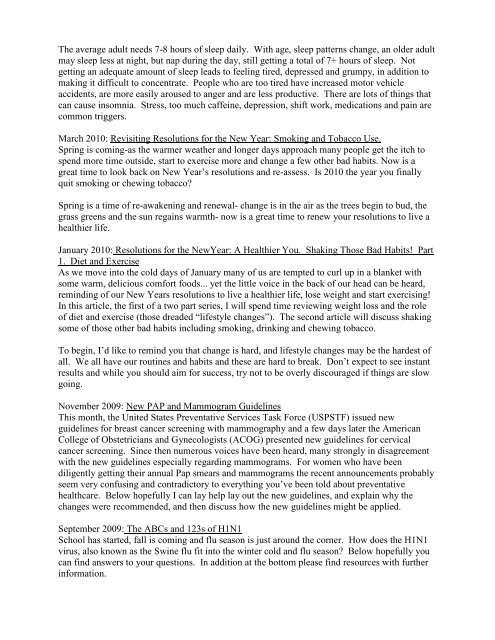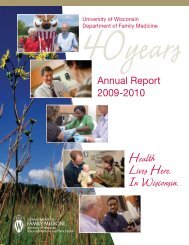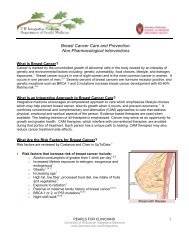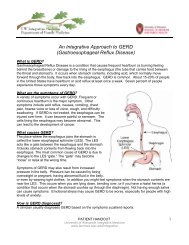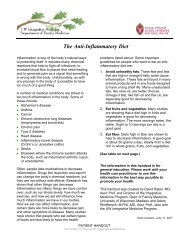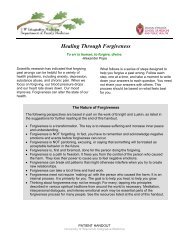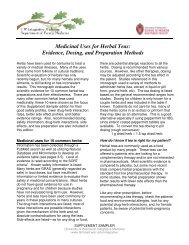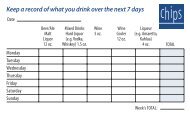RESidENcy PROGRAM Scholarly and Community Medicine Projects
RESidENcy PROGRAM Scholarly and Community Medicine Projects
RESidENcy PROGRAM Scholarly and Community Medicine Projects
Create successful ePaper yourself
Turn your PDF publications into a flip-book with our unique Google optimized e-Paper software.
The average adult needs 7-8 hours of sleep daily. With age, sleep patterns change, an older adult<br />
may sleep less at night, but nap during the day, still getting a total of 7+ hours of sleep. Not<br />
getting an adequate amount of sleep leads to feeling tired, depressed <strong>and</strong> grumpy, in addition to<br />
making it difficult to concentrate. People who are too tired have increased motor vehicle<br />
accidents, are more easily aroused to anger <strong>and</strong> are less productive. There are lots of things that<br />
can cause insomnia. Stress, too much caffeine, depression, shift work, medications <strong>and</strong> pain are<br />
common triggers.<br />
March 2010: Revisiting Resolutions for the New Year: Smoking <strong>and</strong> Tobacco Use.<br />
Spring is coming-as the warmer weather <strong>and</strong> longer days approach many people get the itch to<br />
spend more time outside, start to exercise more <strong>and</strong> change a few other bad habits. Now is a<br />
great time to look back on New Year’s resolutions <strong>and</strong> re-assess. Is 2010 the year you finally<br />
quit smoking or chewing tobacco?<br />
Spring is a time of re-awakening <strong>and</strong> renewal- change is in the air as the trees begin to bud, the<br />
grass greens <strong>and</strong> the sun regains warmth- now is a great time to renew your resolutions to live a<br />
healthier life.<br />
January 2010: Resolutions for the NewYear: A Healthier You. Shaking Those Bad Habits! Part<br />
1. Diet <strong>and</strong> Exercise<br />
As we move into the cold days of January many of us are tempted to curl up in a blanket with<br />
some warm, delicious comfort foods... yet the little voice in the back of our head can be heard,<br />
reminding of our New Years resolutions to live a healthier life, lose weight <strong>and</strong> start exercising!<br />
In this article, the first of a two part series, I will spend time reviewing weight loss <strong>and</strong> the role<br />
of diet <strong>and</strong> exercise (those dreaded “lifestyle changes”). The second article will discuss shaking<br />
some of those other bad habits including smoking, drinking <strong>and</strong> chewing tobacco.<br />
To begin, I’d like to remind you that change is hard, <strong>and</strong> lifestyle changes may be the hardest of<br />
all. We all have our routines <strong>and</strong> habits <strong>and</strong> these are hard to break. Don’t expect to see instant<br />
results <strong>and</strong> while you should aim for success, try not to be overly discouraged if things are slow<br />
going.<br />
November 2009: New PAP <strong>and</strong> Mammogram Guidelines<br />
This month, the United States Preventative Services Task Force (USPSTF) issued new<br />
guidelines for breast cancer screening with mammography <strong>and</strong> a few days later the American<br />
College of Obstetricians <strong>and</strong> Gynecologists (ACOG) presented new guidelines for cervical<br />
cancer screening. Since then numerous voices have been heard, many strongly in disagreement<br />
with the new guidelines especially regarding mammograms. For women who have been<br />
diligently getting their annual Pap smears <strong>and</strong> mammograms the recent announcements probably<br />
seem very confusing <strong>and</strong> contradictory to everything you’ve been told about preventative<br />
healthcare. Below hopefully I can lay help lay out the new guidelines, <strong>and</strong> explain why the<br />
changes were recommended, <strong>and</strong> then discuss how the new guidelines might be applied.<br />
September 2009: The ABCs <strong>and</strong> 123s of H1N1<br />
School has started, fall is coming <strong>and</strong> flu season is just around the corner. How does the H1N1<br />
virus, also known as the Swine flu fit into the winter cold <strong>and</strong> flu season? Below hopefully you<br />
can find answers to your questions. In addition at the bottom please find resources with further<br />
information.


